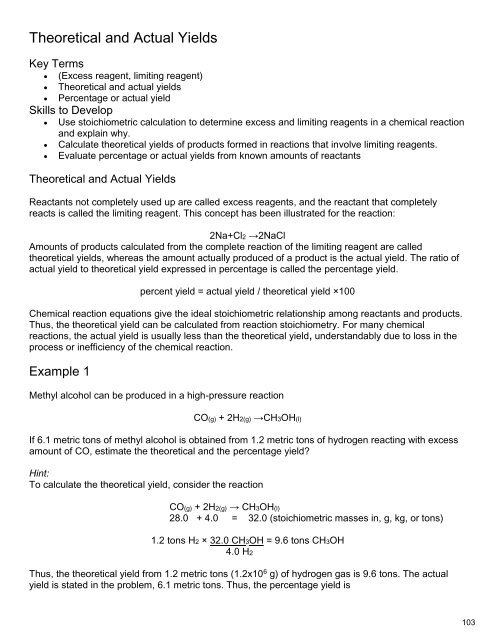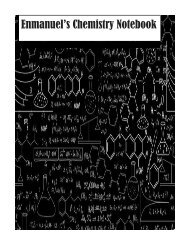You also want an ePaper? Increase the reach of your titles
YUMPU automatically turns print PDFs into web optimized ePapers that Google loves.
Theoretical and Actual Yields<br />
Key Terms<br />
<br />
<br />
<br />
(Excess reagent, limiting reagent)<br />
Theoretical and actual yields<br />
Percentage or actual yield<br />
Skills to Develop<br />
Use stoichiometric calculation to determine excess and limiting reagents in a chemical reaction<br />
<br />
<br />
and explain why.<br />
Calculate theoretical yields of products formed in reactions that involve limiting reagents.<br />
Evaluate percentage or actual yields from known amounts of reactants<br />
Theoretical and Actual Yields<br />
Reactants not completely used up are called excess reagents, and the reactant that completely<br />
reacts is called the limiting reagent. This concept has been illustrated for the reaction:<br />
2Na+Cl2 →2NaCl<br />
Amounts of products calculated from the complete reaction of the limiting reagent are called<br />
theoretical yields, whereas the amount actually produced of a product is the actual yield. The ratio of<br />
actual yield to theoretical yield expressed in percentage is called the percentage yield.<br />
percent yield = actual yield / theoretical yield ×100<br />
<strong>Chem</strong>ical reaction equations give the ideal stoichiometric relationship among reactants and products.<br />
Thus, the theoretical yield can be calculated from reaction stoichiometry. For many chemical<br />
reactions, the actual yield is usually less than the theoretical yield, understandably due to loss in the<br />
process or inefficiency of the chemical reaction.<br />
Example 1<br />
Methyl alcohol can be produced in a high-pressure reaction<br />
CO(g) + 2H2(g) →CH3OH(l)<br />
If 6.1 metric tons of methyl alcohol is obtained from 1.2 metric tons of hydrogen reacting with excess<br />
amount of CO, estimate the theoretical and the percentage yield?<br />
Hint:<br />
To calculate the theoretical yield, consider the reaction<br />
CO(g) + 2H2(g) → CH3OH(l)<br />
28.0 + 4.0 = 32.0 (stoichiometric masses in, g, kg, or tons)<br />
1.2 tons H2 × 32.0 CH3OH = 9.6 tons CH3OH<br />
4.0 H2<br />
Thus, the theoretical yield from 1.2 metric tons (1.2x10 6 g) of hydrogen gas is 9.6 tons. The actual<br />
yield is stated in the problem, 6.1 metric tons. Thus, the percentage yield is




